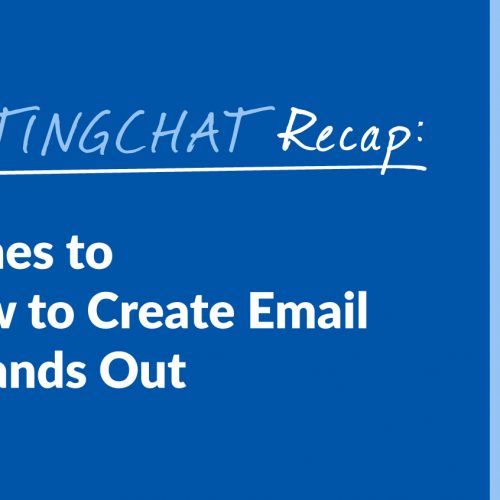10 Hot Email Marketing Tips for 2022
It’s predicted that 333.2 billion emails will be sent and received each day in 2022. It’s proof that email marketing is far from dead. So, if you haven’t gotten your brand moving to take advantage of email marketing, now is the perfect time to start building up your email list. With so many emails sent daily, how can you make sure your emails stand out in a crowded inbox? How do you ensure people take notice? What do you need to do to make sure they consume your content? We’ll cover the answers to these questions and more as we share 10 hot email marketing tips you can use in 2022 and beyond. 10 Hot Email Marketing Tips for 2022 It’s safe to say most of us subscribe to a lot of email newsletters, especially if you run a business. And there’s a good chance many of them get sent straight to the trash unopened. If you want to prevent the same fate from happening to the newsletters you send, keep these email marketing tips in mind: 1. Keep Your Target Reader in Mind When Writing To write truly irresistible emails, you need to put yourself in the shoes of your target reader. What would they want to see in an email from you? What kind of content would they enjoy reading? Whatever it is, that’s what you want to send to them. When they look forward to seeing your name in their inbox, they’re more likely to open and eagerly engage with the content you send. To take it a step further, consider segmenting your email list based on interests or where they are in the buyer’s journey. This makes your content more focused and personalized for the groups of subscribers you target with each campaign. Essentially, it ensures they receive the content they’re most interested in seeing versus getting bombarded with other information. Not only does this increase open rates, but people will be less likely to unsubscribe. 2. Write Subject Lines That Grab Attention Of all the email marketing tips in the world, this is the one you should take the most seriously. Your subject line could make or break the success of your email. It might sound like a lot of pressure, but your subject line is crucial. It’s what people see first thing. Those few words help them decide whether they open your email or send it straight to the trash. If you want to increase your open rates and get people to read the content you so painstakingly crafted, your subject line needs to grab attention. It needs to be descriptive while still being short and sweet. And most importantly, it should never mislead your subscribers. Clickbait subject lines can reduce your read rates by 9% or more. 3. Schedule Emails to Send at Optimal Times After you finish crafting a compelling email, it might be tempting to hit send immediately. However, it might not be the most optimal time for an email to land in your subscribers’ inbox. You want to reach them when they’re more inclined to open and read your content. The tricky thing about finding the right time to send emails is that it tends to vary based on the industry. Although, there is some data you can use to help you narrow down a few times to experiment with. Then, you can see what your unique audience responds to. Here’s some advice from WordStream to get you started: Stick With Daytime: It’s better to send emails to your list when your subscribers are awake. Because you can have subscribers based across the globe and in different time zones, consider the location of most of your audience when choosing your ideal time. Avoid Mondays and Weekends: Many people arrive in the office first thing on Monday morning and delete any unnecessary emails, so you don’t want yours to fall into that category. Emails are often ignored on weekends as well, which is when people tend to disconnect. Go With Tuesday, Wednesday, and Thursday: According to MailChimp, these three days tend to be the favorites when sending email campaigns. Try sending emails on these days to see if one triggers a higher open rate than another. Then, you can choose one day for weekly consistency. At the end of the day, be willing to test and tweak your schedule. Once you’ve figured out the best day and time to send your emails, it’s one less thing you to worry about. Instead, you can just focus on implementing the rest of these email marketing tips. 4. Make Sure Your Emails Are Optimized for Mobile Because you’re sending your emails from a desktop website, it can be easy to forget to check how the result looks on a mobile device. But, most of us are reading our emails on mobile. That’s why you need to take the extra step to ensure your email template and all your content suit a smaller screen. Otherwise, your subscribers will have a hard time reading what you’ve sent, and they could delete your email without engaging. Luckily, many platforms allow you to preview your email on mobile. Often, you can even send a test email to yourself before it goes out to your list. Then, you can make any final tweaks to ensure it’s mobile-friendly and looks great. Take the extra few minutes to do this before sending! As a good rule of thumb, you’ll want to stick to a single-column email template. You’ll also want to choose a font size that’s legible on mobile since subscribers won’t be able to make it bigger. Additionally, you’ll want to double-check the size of any images and buttons that you’ve added. 5. Engage Subscribers Right Off the Bat If you’re not already sending a welcome email (or even an entire welcome sequence) to your new subscribers, you’re missing out. The smartest thing you can do to take your email marketing and your business to the next level is … Read more


